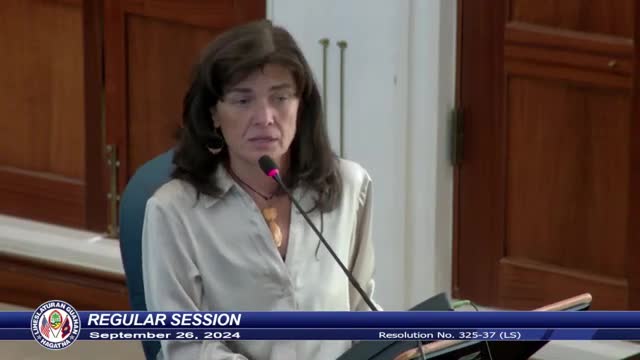Guam leaders fight to protect land and heritage
September 26, 2024 | General Government Operations and Appropriations , Legislative, Guam
This article was created by AI summarizing key points discussed. AI makes mistakes, so for full details and context, please refer to the video of the full meeting. Please report any errors so we can fix them. Report an error »

In a recent government meeting, significant discussions centered around the historical land takings in Guam, particularly concerning the impact on the Chamorro people and the ongoing actions of the Department of the Navy. The meeting highlighted a resolution that aims to address the grievances stemming from decades of land acquisitions, which have displaced local communities and disrupted their social structures.
The resolution, which will be sent to high-ranking officials including the President and the Secretary of the Department of the Interior, underscores the urgency of the situation. It reflects a long-standing concern among Guam's legislators regarding the fairness of land appropriations, particularly those deemed necessary for military purposes. Historical accounts were shared, detailing how the Navy's actions have led to the loss of recreational areas and significant cultural sites, including archaeological artifacts that are vital to understanding Chamorro heritage.
Participants expressed frustration over the Navy's decision to proceed with the construction of a live-fire training range in Rotidian, an area identified as highly destructive to both the environment and historical sites. Despite warnings from environmental studies about the adverse impacts, the Navy has continued its plans, raising concerns about the long-term effects on endangered species and the preservation of Chamorro history.
The meeting also addressed the closure of the Rutidian Wildlife Center, which has been a crucial space for indigenous families for decades. The Navy's restrictions on fishing in the area for over 300 days a year further exacerbate the challenges faced by local communities, who rely on these waters for their livelihoods.
As the resolution moves forward, it represents a critical moment for the Chamorro people and their advocates, who view this as a last stand to protect their land, culture, and future generations from further encroachment and loss.
The resolution, which will be sent to high-ranking officials including the President and the Secretary of the Department of the Interior, underscores the urgency of the situation. It reflects a long-standing concern among Guam's legislators regarding the fairness of land appropriations, particularly those deemed necessary for military purposes. Historical accounts were shared, detailing how the Navy's actions have led to the loss of recreational areas and significant cultural sites, including archaeological artifacts that are vital to understanding Chamorro heritage.
Participants expressed frustration over the Navy's decision to proceed with the construction of a live-fire training range in Rotidian, an area identified as highly destructive to both the environment and historical sites. Despite warnings from environmental studies about the adverse impacts, the Navy has continued its plans, raising concerns about the long-term effects on endangered species and the preservation of Chamorro history.
The meeting also addressed the closure of the Rutidian Wildlife Center, which has been a crucial space for indigenous families for decades. The Navy's restrictions on fishing in the area for over 300 days a year further exacerbate the challenges faced by local communities, who rely on these waters for their livelihoods.
As the resolution moves forward, it represents a critical moment for the Chamorro people and their advocates, who view this as a last stand to protect their land, culture, and future generations from further encroachment and loss.
View full meeting
This article is based on a recent meeting—watch the full video and explore the complete transcript for deeper insights into the discussion.
View full meeting